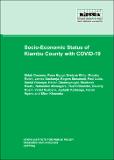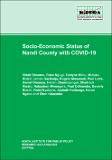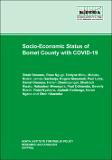Socioeconomic status of Taita Taveta County with COVID-19
Publication Date
2022Author
Type
KIPPRA Publicationsviews
downloads
Metadata
Show full item recordBy
The Kenya Institute for Public Policy Research and Analysis (KIPPRA)
Abstract/
The county total revenue has significantly grown over the years as the Government focus on enhanced services to improve the livelihood of its residents. Total revenue has grown by 15.57 per cent from Ksh 2.79 billion in 2013/14 to Ksh 5.83 billion in 2020/21. Monthly cash transfers from the National government has been exhibiting increasing trend from January to June over the years. Conditional grants are a major source of revenue for financing county operations and has been growing over the years. The share of OSR to total revenue has been stable over time. On average, OSR contributed 5.06 per cent of the total revenue between 2013/14 and 2020/21. During 2019/20 the quarterly OSR collections were robust with marginal decreases compared to 2018/19. The county registered a growth of 89 per cent in OSR collections from Ksh 47.48 million realized during the first quarter to Ksh 89.86 million collected in the third quarter. County expenditure has over the years been rising as the county escalates its efforts in provision of services to its residents. Over the 2013/14 to 2020/21 period, actual expenditure has fell below the 30 per cent of county expenditure and averaged 20.4. In 2014/15 the county reported Ksh 295.5 million in pending bills. This increased to Ksh 709.3 million in 2015/16 with development spending related pending bills accounting for 79.3 per cent of this. To steer the county towards achieving its budgetary objective and development goals contained in the ADPs and CIDP, the county to ensure that the ongoing projects are completed before launching new project sand clear any pending bills and arrears owed to suppliers; ensure the ongoing infrastructure project are completed and suppliers paid within the specified timelines for optimal returns to investment and to spur private sector activity and improve budget execution and absorption of development budget by harmonizing project implementation cycles to budgeting and fast-track exchequer releases.
Subject/
Covid-19 implications; Strategy implementation; Sectoral planning; County planning; COVID emerging issues
Publisher
The Kenya Institute for Public Policy Research and Analysis (KIPPRA)Series
Special Report;2022;Collections
Related items
Showing items related by title, author, creator and subject.
-
Socio-Economic Status of Kiambu County with COVID-19
The Kenya Institute for Public Policy Research and Analysis (KIPPRA) (The Kenya Institute for Public Policy Research and Analysis (KIPPRA), 2022)The county total revenue has significantly increased over the years as the Government focus on enhanced services to the citizens. In Kiambu County, total revenue increased from Ksh 7.8 billion in 2013/14 to Ksh 15.48 ... -
Socio-Economic Status of Nandi County with COVID-19
The Kenya Institute for Public Policy Research and Analysis (KIPPRA) (The Kenya Institute for Public Policy Research and Analysis (KIPPRA), 2022)Nandi County total revenue has significantly grown over the years as the government focuses on enhanced services and amenities for the citizens. Total revenue increased from Ksh 4.07 billion in 2013/14 to Ksh 6.65 billion ... -
Socio-Economic Status of Bomet County with COVID-19
The Kenya Institute for Public Policy Research and Analysis (KIPPRA) (The Kenya Institute for Public Policy Research and Analysis (KIPPRA), 2022)This study by KIPPRA investigates the socio-economic impact of COVID-19 on Bomet County. Using a mixed-methods approach, it analyzes indicators like household income, employment, healthcare access, and education. The ...




